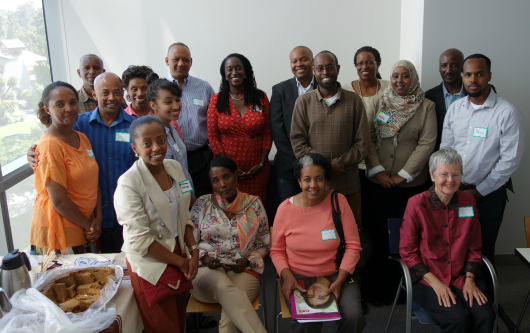
The Silicon Valley East African Diaspora Project represents immigrants from six nations: Eritrea, Ethiopia, Kenya, Somalia, Sudan and South Sudan (Michael Cheers photo).
The uncertain future of the diversity visa program and a novel online timeline tool are heightening interest in a new King Library exhibit sharing immigration stories of Silicon Valley’s East Africans.
But equally important is the way “Celebrate!” tells the story of an immigrant experience familiar to so many in the South Bay, perhaps the most ethnically diverse community in the nation.
The show opens Aug. 31 and continues through Sept. 29 at the Jennifer and Philip Di Napoli Gallery on the second floor of King Library.
Expect photojournalism, digital technology, films, cultural memorabilia, and text to introduce immigrants from six East African nations: Eritrea, Ethiopia, Kenya, Somalia, Sudan, and South Sudan.
“‘The exhibit will increase the visibility of our region’s East African immigrants and their contributions to its economic, cultural, religious, and intellectual growth,” said Project Director and Professor of African American Studies Ruth P. Wilson.
Here are more details from SJSU’s Silicon Valley East African Diaspora Project.
Photojournalism
Along the surfaces of seven gallery walls will hang portraits of East Africans engaged in work, family life, community events and faith. Most poignantly captured is the intensity of the commitment of persons engaged in collective worship activities, family life and work. Whether in an evangelical healing service, a mosque or a Coptic church, immigrant communities of faith seek meaning in their new home away from home, find hope as they work to survive and thrive, and find comfort in celebrating the cultural rituals that make life more meaningful for individuals and families.
They consistently strive to support family members here, and in their home countries, who depend on them for some of the basic necessities: food, shelter, school fees, medicine, hospital care and funeral expenses. This collection of more than 50 photographs by photojournalist Associate Professor of Journalism and Mass Communications D. Michael Cheers captures the similarities and diversities of gendered, ethnic, religious, socio-economic and family experiences in these East African diaspora communities.
Telling Our Stories
TimeShaker, a Silicon Valley start-up, presents a new way to tell our immigrants’ stories. “What was the sequence of events that brought you to the U.S.?” and “What were the key events that have happened since arriving?” View these immigrants’ stories on a timeline, and overlay other pieces of history such as the history of their homeland or the history of U.S. immigration policies.
This allows you to see their stories relative to the world around them. These stories seek to evoke the audience’s sense of connection not only to these immigrants, but all immigrants as they face the challenges of adjusting to living in another country. In this part of the exhibit, visitors will view a short video that introduces the East African immigrants’ stories, then log into
Visit TimeShaker’s online portal to read the rest of the stories using an interactive, digital storytelling tool.
Films
Film screenings will evoke discussions, sharing of insights, and education of the general public about issues confronting East Africans in the United States and on the African continent. Some of these provocatively informative films, including but not limited to Salem Mekuria’s documentary “Deluge- Yewenze Meabel,” Kobina Aidoo’s “The Neo-African Americans”, and Vulcan Productions and Intel Corporation’s “Girl Rising,” will be shown on Saturday and Sunday afternoons, in Room 227, right
across from the main exhibit. Each film addresses important issues for immigrant communities in the valley, in their home countries, and in diaspora communities throughout the world. Scholars and community activists will lead the discussions and panels after the screenings.
Cultural Memorabilia
Six display cases will be dispersed throughout the exhibit, one for each of the six East African nationalities represented in the exhibit. Each case will contain cultural memorabilia treasured by immigrant communities. While viewing jewelry, beaded objects, woven tapestries, stoneware, religious relics, carvings, coffee pots used in coffee ceremonies, cooking utensils, prayer beads, etc., visitors will realize the homogeneity and diversity of some of humanity’s most ancient human civilizations and cultures.
The Meaning of Democracy
This text-based visual display seeks to explore themes in immigrant interviews on the meaning of democracy. It attempts to bridge the gap between a concept that has special meaning for immigrants’ nascent democracies, and America’s, where many citizens take the right to participate in governance for granted, often foregoing the most basic of civil responsibilities—
participation in the selection of candidates for office, and the right to vote. Featured are East Africans’ thoughts on the promise of democracy and their hopes for more opportunities offered in the Valley and in their distant homelands.
When Africa calls, East Africans answer. They travel throughout California, the nation and abroad for worship, weddings, sporting events, funerals, graduations, birthday parties, christenings, and feasts.
And, family members from the home country come to America to celebrate many other important family events. No matter what, East Africans’ enthusiastic celebrations include cultural foods, dance, music, colorful dress, and congregating as a community. Join them at “Celebrate!”
Participating community organizations include: Bay Area Somali Association, Bay Area South Sudan Association, Eritrean Community and Cultural Center of San Jose, the Eritrean Community Center of Santa Clara, and the Ethiopian Cultural and Community Center.
Sponsors include the African Women’s Development Fund USA and the Cal Humanities California Documentaries Project.

